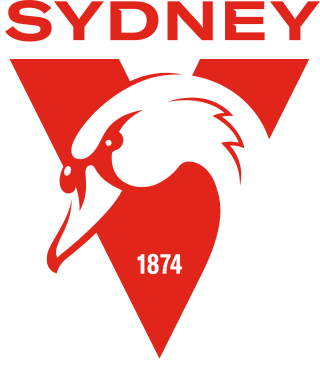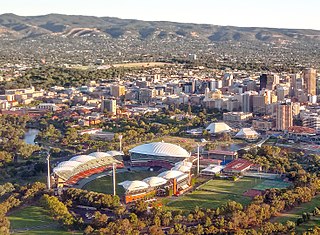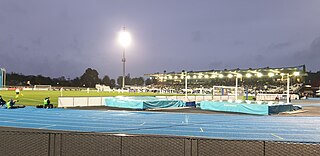
The Sydney Swans are a professional Australian rules football club based in Sydney, New South Wales. The men's team competes in the Australian Football League (AFL), and the women's team in the AFL Women's (AFLW). The Swans also field a reserves men's team in the Victorian Football League (VFL). The Sydney Swans Academy, consisting of the club's best junior development signings, contests Division 2 of the men's and women's underage national championships and the Talent League.

The South Australian National Football League, or SANFL, is an Australian rules football league based in the Australian state of South Australia. It is also the state's governing body for the sport.

The Adelaide Oval is a sports ground in Adelaide in the state of South Australia. It is located in the parklands between the city centre and North Adelaide. The venue is predominantly used for cricket and Australian rules football, but has also played host to rugby league, rugby union, soccer, and tennis, as well as regularly being used to hold concerts.

Hindmarsh Stadium is a multi-purpose stadium in Hindmarsh, an inner western suburb of Adelaide, South Australia. It is the home of the Australian A-League team, Adelaide United.
North Ipswich Reserve, known as Qld Group Stadium or commercially Bendigo Bank Oval, is a sports venue in Ipswich, Queensland. Originally an Australian rules football oval, it became a primarily rugby league venue in the 1920s as that code experienced an explosion in local popularity. It is currently home to the Ipswich Jets, who play in the Queensland Wizard Cup. On occasion the venue plays host to National Rugby League trial matches, most recently when the Sydney Roosters played the Jets.

Australian rules football has been played continuously in the Australian Capital Territory since 1911 and was the most popular football code in the nation's capital Canberra between 1978 and 1982. The current governing body is AFL Canberra founded 1922, while the development body is AFL NSW/ACT established in 1999.

Australian rules football is the most popular sport in the Northern Territory (NT), particularly among Indigenous Australian communities in Darwin, Alice Springs and the Tiwi Islands. It is governed by AFL Northern Territory. In 2017, it was reported that 18% of Territorians participate in Australian rules football—the highest rate of participation in Australia. The sport also produces more professional AFL players per capita in the than any other state or territory.

Australian rules football in South Australia has long been the most popular sport in the state. It is governed by the South Australian Football Commission which runs the South Australia National Football League, the highest profile competition among the 24 spread across the state. South Australia has the third most players of any state and has the second highest participation rate per capita (4.8%). It is the only state in Australia where Australian rules football participation is higher than soccer.
The 1991 AFL season was the 95th season of the Australian Football League (AFL), which was known previously as the Victorian Football League until 1989. The season ran from 22 March until 28 September, and comprised a 22-game home-and-away season followed by a finals series featuring the top six clubs, an increase from the top five clubs which had contested the finals since 1972.
The 1994 AFL season was the 98th season of the Australian Football League (AFL), the highest level senior Australian rules football competition in Australia, which was known as the Victorian Football League until 1989. The season featured fifteen clubs, ran from 26 March until 1 October, and comprised a 22-game home-and-away season followed by a finals series featuring the top eight clubs – an increase from the six clubs which had contested the finals in previous years.

Sampson Hosking was an Australian rules footballer who played for the Port Adelaide Football Club in the South Australian Football League (SAFL). He was twice a recipient of the Magarey Medal, an individual award given in recognition of being the best and fairest player in the SAFL. After his playing career Hosking was also an accomplished football coach successfully leading Port Adelaide and the West Torrens Football Club to a combined six premierships. In 1929 he was described in the Register as "one of the most prominent figures in the game during the past 20 years. Combining exceptional pace with a football brain of rare fertility".

Lakeside Stadium is an Australian sports arena in the South Melbourne suburb of Albert Park. Comprising an athletics track and soccer stadium, it currently serves as the home ground and administrative base for association football club South Melbourne FC, Athletics Victoria, Athletics Australia, Victorian Institute of Sport and Australian Little Athletics.

William Harold Oliver was an Australian rules footballer. Harold Oliver was a key player to some of South Australian football's most successful teams. He starred in South Australia's victorious 1911 Australian football championship along with Port Adelaide's 1914 "Invincibles" team. After being close to retiring from the game after World War I, he returned to captain both Port Adelaide to the 1921 SAFL premiership and South Australia in a game against Western Australia. His reputation as an early exponent of the spectacular mark—along with his general skill at playing the game—saw him regarded as one of the best players South Australia has produced.

Angelo Nicholas Goucar Congear was an Australian rules footballer who played for the Port Adelaide Football Club in the South Australian National Football League between 1908 and 1922.

The 1942 SANFL Grand Final was an Australian rules football game contested between a merger teams of Port Adelaide–West Torrens ("Port–Torrens") and West Adelaide–Glenelg ("West–Glenelg"), held at the Adelaide Oval on Saturday 19 September 1942. It was the 44th annual Grand Final of the South Australian National Football League, stated to determine the premiers of the 1942 SANFL season. The match, attended by 35,000 spectators, was won by Port–Torrens by a margin of 11 points, marking that mergers first premiership.

Alexander McKenzie was an Australian rules footballer for Port Adelaide. He was noted to be able to kick a football 75 yards without the assistance of wind.

The 1916 SAPFL Grand Final was an Australian rules football game contested between the Port Adelaide Football Club and the West Torrens Football Club, held at Hindmarsh Oval on Saturday 19 August 1916. It was the 1st Grand Final of the South Australian Patriotic Football League, staged to determine the premiers of the 1916 SAPFL season. The match was won by Port Adelaide by a margin of 34 points, marking that clubs first patriotic premiership victory.

The 1917 SAPFL Grand Final was an Australian rules football game contested between the Port Adelaide Football Club and the West Torrens Football Club, held at Alberton Oval on Saturday 1 September 1917. It was the 2nd Grand Final of the South Australian Patriotic Football League, staged to determine the premiers of the 1917 SAPFL season. The match was won by Port Adelaide by a margin of 16 points, marking that clubs second patriotic premiership victory.

The 1918 SAPFL Grand Final was an Australian rules football game contested between the West Torrens Football Club and the West Adelaide Football Club, held at Jubilee Oval on Saturday 9 October 1918. It was the 3rd Grand Final of the South Australian Patriotic Football League, staged to determine the premiers of the 1918 SAPFL season. The match was won by West Torrens by a margin of 14 points, marking that clubs first patriotic premiership victory.

The 1918 SAPFL season was the 3rd and final season of the South Australian Patriotic Football League, a competition formed in the absence of the South Australian Football League during World War I. The SAFL was opposed to the formation of the Patriotic League and refused to recognise it during and after World War I.

















